| کد مقاله | کد نشریه | سال انتشار | مقاله انگلیسی | نسخه تمام متن |
|---|---|---|---|---|
| 4545690 | 1626960 | 2011 | 6 صفحه PDF | دانلود رایگان |

Octopus (Octopus vulgaris, Cuvier) plays a central role in the marine food web, being an important consumer with high metabolic rates and at the same time an important food item for higher predators. After harmful algal blooms, octopus can accumulate high levels of marine toxins trough trophic interrelationships. The aim of this study is to characterize the distribution of paralytic shellfish toxins (PSTs) in selected tissues of the O. vulgaris, in order to assess the translocation of toxins among organs with different physiological functions. Different retention times and selective elimination of particular toxin analogues were also investigated. Twenty three specimens of O. vulgaris were captured in Peniche (NW coast of Portugal) after PSTs have been detected in molluscan bivalves. Tissue matrices were dissected from organs with digestive function (digestive gland, stomach and salivary glands) and excretory function (kidneys and branchial hearts) and analyzed for toxin determination. Toxin analysis was carried out by high performance liquid chromatography with fluorescence detection (LC-FLD). PSTs were found in all tissues analyzed. The highest toxin concentrations were found in the digestive gland, reaching a maximum of 2980 μg STX equiv. kg−1. The toxin profile was constituted by dcSTX, B1, C1 + 2, dcGTX2 + 3, dcNEO, STX and GTX2 + 3. A lower number of toxins were identified in the remaining organs, with B1 and dcSTX compromising more than 90% in molar fraction. Decarbamoyl saxitoxin was the most abundant toxin detected in digestive gland, stomach and salivary glands, while B1 was dominant in organs with excretory function. A positive correlation of concentrations of B1 and dcSTX were found in the organs analyzed. Results indicate that B1 and dcSTX are assimilated into the digestive gland in a similar proportion. Selective elimination of toxins with higher elimination of B1 and retention of dcSTX is suggested. This study contributes to better understanding of the dynamics of PSTs in O. vulgaris and the fate of PSTs in the food web.
• PSTs tissue distribution and routes of toxin clearance in octopus.
• High accumulation in the digestive gland and main elimination route based on renal processes.
• B1 and dcSTX are the most abundant toxin analogues in each organ analyzed.
• Selective elimination of toxins with easier excretion of B1 than dcSTX.
Journal: Harmful Algae - Volume 10, Issue 6, September 2011, Pages 732–737